Justin Robinson's Blog, page 21
April 13, 2014
GET BLANK stretch goals!
What is Rosicrusophy? Well, religious copyright laws being what they are, I can't come right out and tell you. But, assuming we hit $750 of funding in the next 25 days, you can find out for yourself!
Rosicrusophy helped the biggest stars in Hollywood get where they are. Don't you want to see what it can do for you?
https://www.kickstarter.com/projects/...
April 11, 2014
Now Fear This: Hansel and Gretel: Witch Hunters

Don’t underestimate the eye candy.
In theory, Netflix is amazing: any movie you could ever want to watch, just a click and a modest subscription fee away. In fact, what you get are a couple movies you really want to watch and then a whole bunch that you’ve never heard of, look terrible, and finally answer the question, “Oh, that’s where Josh Hartnett has been hiding.” For TV shows, it’s pretty awesome, even if they refuse to put The Shield on there. Anyway, one evening Mrs. Supermarket and I were looking for something to watch, and one of those terrible-looking films popped up on the menu (selected by Netflix’s fevered criteria; “because you watched Flight, you’ll like movies that give you the experience of cocaine”), and we looked at each other and went, “You know what? What the hell.” That movie was Hansel & Gretel: Witch Hunters.
Right away, we knew this wasn’t quite what we signed up for. We expected the usual long list of hired guns for the writer credit, and someone like McG or Brett Ratner slumming it for the director. Nope, the writer and director are the same guy: Tommy Wirkola, best known for the cult Nazi/zombie flick Dead Snow. If that weren’t enough, the producers are Will Ferrell and Adam McKay, a.k.a. the guys who made the two best comedies of the last ten years. This is all over a kinetic credit sequence of olde-timey newspaper headlines and simulated collage animation telling the story of the two most famous witch hunters in the world: the former victims Hansel and Gretel now all grown up and badass. This promises us the dumb fun of the poster, but hints that there might be a little more going on underneath the glitz.
And boy is there. The film places its tongue rather firmly in cheek with the opening narration, delivered by Jeremy Renner’s Hansel. For one thing, Renner doesn’t even attempt an accent; he keeps the San Joaquin drawl that’s served him well on his journey toward well-deserved stardom. As his sister, Gemma Arterton even attempts one of those “American” accents the Brits must teach their first year of acting school. The narration, subsequent dialogue, and line readings establish Hansel and Gretel as anachronistic American cowboys, witch hunters from a good old U.S. of A that might not even exist yet. The level of technology supports this: Hansel uses a retro-future pump action shotgun, while Gretel favors a crossbow with the rate of fire of an assault rifle. Miniguns and syringes (the latter treating one of the film’s cleverer flourishes: Hansel’s super-diabetes contracted after mainlining candy in the original myth) also make appearances, as does a gag based around putting a missing kid’s picture on a milk carton. The message is simple: don’t worry what time it is. Just watch this cool shit we’re about to do.
Hansel and Gretel are the western ideal of wandering badasses for hire, and they’ve been contracted by a small German hamlet to deal with the rash of witch activity and child abductions. The characters are reintroduced (the cold open of the film is a retelling of the famous bedtime story) rescuing a young woman accused of witchcraft. This woman, Mina, becomes Hansel’s love interest in the story. She’s also a redhead, and loyal readers will remember exactly what that means. (Also, yes, there is a significant redhead named Mina – total coincidence, but I’d be lying if I said I didn’t like that.) Yes, Mina’s a witch, but she’s a good witch, which is something that our titular heroes didn’t even know existed.

WIIIIIIIIIIIIIIIIIITCH!!!
The cause of all the problems are a coven of three witches — there are always three — led by grand witch Muriel (the eternally young Famke Janssen) who are in the midst of a doomsday plot. See, there’s one thing that reliably kills witches, and it’s the one thing Hansel and Gretel found out when they decided to go all Aesop Unchained on their tormentor: fire. Muriel’s big plan is to grant witches immunity, and so they’ll be free to steal kids wherever they go. Well, not free, since this won’t protect them against Hansel and Gretel’s arsenal of anachronistic death, but it’s the next best thing.
The film might have been as bad as it looked, as disposable and instantly forgettable as its poster implied, but for one simple fact: it’s rated R. I wanted to sing and dance during the first explosion of gore. I wanted to shake Wirkola’s hand at the gratuitous-yet-tasteful nudity. I wanted to fire my gun up in the air every time Hansel or Gretel said “fuck.” While it would be easy to dismiss the movie as wallowing in the baser aspects of our nature, in fact it’s the opposite. The hypocrisy of the MPAA is well-documented elsewhere, but suffice it to say, I infinitely would prefer that children see the consequences of violence (in the form of blood and injury), than to think that it’s good clean fun. Also, boobs never hurt anyone. As for cursing, I’m sorry: I don’t believe in magic words. The movie’s rating frees Hansel & Gretel to create the kind of delirious action romp that feels like the Shaw Brothers by way of John Carpenter.
The creature design reinforces the retro aesthetic. The grand finale features witches from all over the globe, and many of the performers appear to be recruited directly from the circus. When you have excellent makeup supported by a performance with the interesting physicality of a human prodigy, you turn a forgettable face in the crowd into a visually fascinating character. The FX team went all out in their character design, even for individuals who exist only to be blown away in a hail of magical gunfire. Edward the troll, a reluctant servant of Muriel’s, is similarly well-designed. Wirkola wisely switches the trick when filming him, alternating between a man in a suit, a puppet, and (for a few brief shots) a CG creature. Edward could probably have been done by digitally enlarging a human performer, but the old school creature creation gives him both weight and a pleasantly inhuman mien. It’s a case of a filmmaker going the extra mile when he didn’t have to, and it pays dividends.
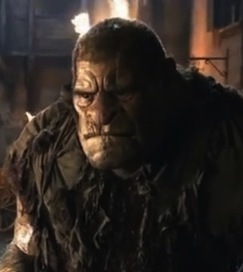
“She said she was Team Jacob…”
Hansel & Gretel: Witch Hunters wasn’t going to win any Oscars, but then, it never wanted to. It merely wants to entertain, by any means at its disposal, and it does just that. In an age of bloated, bloodless blockbusters, sometimes all you need is something lean and mean with a little red on the bone.
Filed under: Projected Pixels and Emulsion Tagged: Famke Janssen, Gemma Arterton, Hansel and Gretel: Witch Hunters, Jeremy Renner, Now Fear This, Tommy Wirkola

April 10, 2014
GET BLANK kickstarter is live!
https://www.kickstarter.com/projects/...
April 4, 2014
Con Life
My past two weekends have been spent in big echoey rooms, sitting in cold spots that could only be caused by an extremely angry ghost, making small talk with total strangers, trying to convince them that in a shitty economy, they should drop some cash on an author they’ve never heard of. In other words, I was manning my booth at a pair of conventions. The first, ConDor, a science-fiction/fantasy convention in (normally) sunny San Diego, was over my birthday weekend; the second was Emerald City Comic-Con in Seattle, the Bib Fortuna to San Diego Comic-Con’s bloated Jabba the Hutt. As you can see from my con schedule, I do a lot of these, so I thought I’d talk about them a bit. It might be my skewed perspective, but conventions seem to be taking outsized importance in the life of fans, and they can be a good place to promote your books/comics/webseries/interactive goat-fertilization vines.

I feel dirty.
I’ve been attending San Diego Comic-Con every year since 2002, and it’s one of the written-in-stone engagements on my social calendar. In early days it was as a guest, then I worked a friend’s booth for an exhibitor pass, and for the last seven or so years, I’ve been going as a professional. My time at Comic-Con coincidentally lines up almost exactly with its growth from merely large to something grotesque and unwieldy that even devotees hate at times. The first year I went, I showed up on Saturday afternoon, stood in line, and bought a pass for both remaining days. To anyone who has attempted the Thunderdome that is the online registration process, this sounds like the ravings of a madman, but I assure you, it happened. These days, there is no admission at the door. You roll the dice on the long shot you’ll get an attendee badge, or you get creative with labor commitments, resume, or qualifications. SDCC is such a madhouse that it barely makes sense for someone’s first con — it’s like making prospective trainers at Sea World go out and capture their own orca bare-handed. The growth of the con has altered it in ways that a lot of the old-timers (even “old-timers” who have only been going for a couple years) bemoan that it’s no longer even tangentially about comic books; Comic-Con has become a place for studios to test their ostensibly nerd-friendly movies and TV shows. Comics have remained a tiny and tenacious part of the con, but really for the last six years, I’ve been taking SDCC as an excuse to party with my friends in San Diego while I pick up the newest Rick Geary book.
My first convention flying solo as an exhibitor was the Long Beach Comic & Horror Con in November of 2012. My third (though I wrote it first) book had just been published in completed form, and I was ready to move some paper. Well, I thought I was ready. I was lucky enough to have Con Mentors in the form of Clint and Dawn Wolf of the fantastic Zombie Ranch so I had some idea of how this thing was done. As it turns out, I was basically Jon Snow when it comes to not knowing shit (sadly, not in terms of being super duper sexy). It’s been about a year and a half, and I just finished up my first back-to-back con appearances in two different cities, neither of which is my home base. I might finally have the hang of this thing. Maybe. A little bit.
It’s kind of astounding how much there is that you wouldn’t even think about. You need a tablecloth to cover whatever you’re setting up on, a banner behind you to catch the eye and give you some height, shelving to display what you’re selling and to provide texture, giveaways to draw people in, money in easily changeable denominations, something to let you accept credit cards, and a book. Oh god, how you will want a book about halfway through your first day sitting on your ass. Snacks too, and you’re best off with something cheap and healthy. And, because it’s me, a giant fucking bottle of iced tea.

Yeah, that’ll last an hour. Hour and a half tops.
Just as important, and the place I’m still lagging behind, is getting your patter down. There’s a weird line when it comes to people checking out the booth. It’s a good idea to greet anyone who stops by, but a bad idea to try to rope people in from afar. Mostly because at any sort of convention, introversion is the norm and introverts don’t like being shouted at like carnival elephants. I went too far in the other direction, and when I changed my approach (thanks to the advice of my loyal Gal Friday), I had the best day in sales in a long time. I greeted newcomers, then, if they made eye contact, engaged them with actual questions, and letting them come to the books organically. It helps to have a quick elevator pitch for prospective buyers. My problem is that I have seven published books in six genres (and that number is only growing), and I easily get flustered when the time comes to talk myself up. Actually talking with my visitors helped alleviate that, so when I asked what kinds of things they normally liked, I could steer them in the proper direction. Urban fantasy, but want something a little different than the sword-wielding warrior-women and sexy werewolves? Try Coldheart. Mysteries, but want a unique variation on a theme? Mr Blank and City of Devils will treat you right. Bone-crunching zombie death, but with a plot? Undead On Arrival is the way to go. Horror, but want something more disturbing than your average monster-menaces-normal-folks? Everyman.
I’ve got a couple weekends off before WonderCon! I’ll be launching the Get Blank kickstarter by then, complete with all new conspiracy cards. And at least that one is in my backyard.
Filed under: Nerd Alert Tagged: comics, ConDor, conventions, Emerald City Comic-Con, pop culture

March 28, 2014
Providing Leverage
Leverage was, while it was on, one of those shows I never looked forward to. I was always happy to watch it, and it never failed to entertain, but it never sunk its hooks into me the way other shows have. It was an hour of pleasantly diverting TV that came and went from my consciousness without putting up too much of a ruckus. But since it came to an end (at the right time, I should add — the cons were not quite as fresh as they had once been), I’ve found myself turning to it as comfort TV. I queue up an episode on Netflix, and bam, instant good mood.
The show is a Robin Hood fantasy for the modern age. Four super-criminals are led by a brilliant and honest man to bring down rich and powerful wrongdoers the law will never touch. And they do it with style. It’s Ocean’s Eleven every week with the same crew, and while the reversals might not bear up to close scrutiny, it’s entertaining enough for it not to matter. The best part of the show’s mission statement is giving each of its team a role and then allowing them to shine. Though there’s a certain amount of bleed-through on all of them, the iconic nature of the Hitter, Hacker, Grifter, Thief, and Mastermind means that the show is the simple pleasure of watching awesome people do awesome things awesomely.
I have trouble letting go of something I love, but I’m not suggesting that we bring back the same crew. That’d be too easy. What I’m suggesting is that we make a new crew out of other great characters. A new Leverage team filled up with badass ringers.
Hitter
The most cathartic point of any episode is when Eliot Spencer (Christian Kane) gets to punch some of the bad guys. This is because Eliot is a master of the kind of freeform mayhem you don’t see outside of Arkham City. Eliot’s primary job on the con is to keep everyone safe, and his prescription for this is always fists. In this role, you need someone comfortable with a wide variety of weapons, and if they can help out on a con, so much the better. In short, you need Chuck’s Sarah Walker (Yvonne Strahovski), the former CIA assassin turned bodyguard for everyone’s favorite nerd. She kicks a comparable amount of ass, and she’ll have a similar effect on the opposite sex.
Why this isn’t Buffy: Her romantic track record of falling in love with soulless monsters would inevitably lead to her falling for the mark.
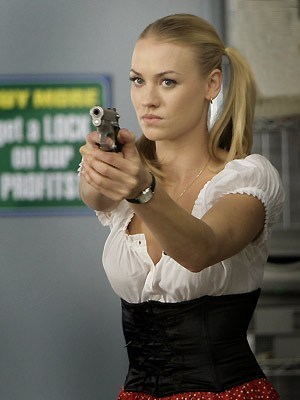
Do not try to con the Wienerlicious.
Hacker
It’s hard to replace Alec Hardison (Aldis Hodge), because, let’s face it, the guy’s a wizard. Hardison was a combination of Q, the bad guy in Die Hard 4, and a non-evil Sauron. While the others went in, Hardison directed the action, unlocked doors, and cut camera feeds. He built false identities, planted fake websites, hacked banks and government installations. There were times when the team was pretty much Hardison and his Amazing Friends. Hardison is impossible to replace, but you know who comes close? Job from Banshee. He probably can’t con for shit, what with him refusing to talk like anything but a Southern preacher in drag. But he can hack, oh boy howdy can he hack. And even better, he’s a criminal in the Banshee universe, which means he’s also an unstoppable kicking machine.
Why this isn’t Mac: She was more of a troublemaker than a super criminal.

Here come the motherfucking neighborhood.
Grifter
Sophie Devereaux (Gina Bellman) is the kind of elegant master criminal who puts the “artist” in “con artist.” She’s European, she steals priceless works of art, she plays a variety of upper-crust characters, she’s been involved in famous thefts that are so cunningly done, they’re not even recognized to be thefts until she’s long gone. While there’s no one quite like that around, there is a man who spent a lot of his time conning people into destroying themselves: Burn Notice’s Michael Westen. Sure, he’s a little more working class, but he once convinced a mark he was the Devil himself. Almost anyone from that show would be a good choice here, but you might as well go for the team leader. Especially because Michael’s skills are still fresh and if push comes to shove, he can always call the band back together.
Why this isn’t someone on Scandal or Gossip Girl: I don’t watch those.

He used to be a spy.
Thief
Aren’t they all thieves? Well, yes, but there’s one member of the team whose job it is to do thief-type stuff. You know, the kinds of things that are class abilities for rogues in D&D. Someone to climb, slink through air ducts, pick locks. The physical part of thievery. Parker (Beth Reisgraf) did this with a ridiculously bendy body and nimble hands, but always faltered in the social aspect, due to falling somewhere on the spectrum. White Collar’s Neal Caffrey loses a bit on the physical side, but what he picks up on the social, to say nothing of his skills as a forger, says he’s a good addition. The only problem would be if Sophie ever met him. That would have to be love at first sight.
Why this isn’t Hannibal Lecter: Yeah, he plants evidence in the FBI and can move through the air like a ghost. He’s also super duper evil. Can’t have him on the team.

Also? How is anyone allowed to be that handsome?
Mastermind
You need someone with conscience, but not so much that they’re not comfortable playing a ruthless full-contact chess game with the kinds of sociopaths that make up the insanely rich. That’s why Nate Ford (Timothy Hutton) was the perfect choice. A former insurance investigator whose son died when his insurance refused to cover an expensive treatment (yes, number Leverage among those shows that could only exist in America), Nate assembled the four greatest criminals in the world and gave them a purpose. There’s only one other character with this kind of experience: Ellen Parsons of Damages. She went up against Patty Hewes, a perfect picture of a powerful sociopath, and won, only walking away because she didn’t like what it did to her. Here, she’d be able to fight the good fight without compromising herself.
Why this isn’t Coach: Didn’t you watch Friday Night Lights? His team always got wrecked in the first half. If you’re going to do a con, you need to scout the opposition a little, which Coach apparently never did.

We provide… Damages.
And there you have it, Sarah Walker, Job, Michael Westen, Neal Caffery, and Ellen Parsons: your new Leverage team.
Filed under: Projected Pixels and Emulsion Tagged: Ellen Parsons, Job, Leverage, Michael Westen, Neal Caffrey, Sarah Walker

March 21, 2014
Girls, Guns and G-Strings: Fit to Kill
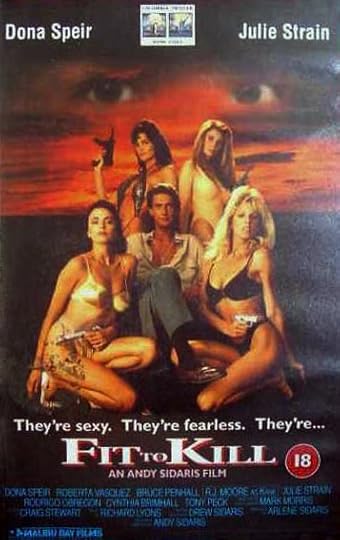
I don’t think “Fit to Kill” is actually an expression.
Fit to Kill (1993)
Cast: Dona Speir, Roberta Vasquez, Bruce Penhall, RJ Moore, Tony Peck, Cynthia Brimhall, Ava Cadell, Carolyn Liu, and Michael Shane are all back as (respectively) Donna Hamilton, Nicole Justin, Bruce Christian, Kane, Lucas, Edy Stark, Ava, Silk, and Shane Abilene.
Other Sidaris regulars return as well in different(?) roles. Rodrigo Obregon gets a blond dye-job and repurposes his Hispanic accent as Russian in the role of diplomat Mikael Petrov. Richard Cansino and Chu Chu Malave are back as yet another (or possibly the same) pair of dimwitted assassins, this time codenamed Evel and Knievel. Skip Ward also returns as Skip, another guy who looks the same and has the same name who dies in a fiery explosion. I like to think it’s the same person doomed to this pointless existence by a heartless deity. Skip, trapped in a hell even Dante could not conceive. Brett Baxter Clark is also back as the yacht captain, but this time he gets a name (Burke) and a sex scene (weird), so that’s a promotion.
Julie Strain, who will later become a more important part of the Sidarisverse, plays the villainous assassin Blu Steele, and yes, I can’t type that without giggling.
Non-Actor Quotient: Playmates Speir, Vasquez, and Brimhall, of course, along with Ava the “loveologist.” The role of “Becky,” or the fried-blonde who hangs out topless at the station so Shane can sleaze all over her has been replaced by Sandra, played by Sandra Wild. I’m not sure if Wild is a non-actor or not, but she’s certainly not very good at it, and there are a ton of Playboy videos on her IMDB page. Julie Strain, though she has a ton of titles on her CV, got her start in the pages of Penthouse, as their 1993 Pet of the Year. I feel like this is a step down for Sidaris.
IMDB Plot Keywords: diamond, red panties, nude, lingerie, erotic thriller
IMDB User Lists Appearing On: …And The Ugly of the 1990s, All the movies I’ve seen, Terrible Movies I’ve Seen or Want to See, DVDs and Blu-Rays I Own, Owned Movies on DVD
Synopsis: During a wargame, Donna and Nicole soundly defeat Bruce and Shane, but let their guard down when the perceived danger passes. This allows Lucas, using the new RC helicopter designed by Dr. Emerson (I guess they lost the previous one) to surprise and fake kill them. In a normal movie, this would be where we learn whenever problem the main character would spend the movie getting over, but that’s not how Andy Sidaris works. He just wanted to show off this cool helicopter.
Meanwhile, a weird lady (who we later find out has the not-at-all made up name of Blu Steele) is on a roof in Vegas doing warrior poses while dressed in something from Frank Frazetta’s yard sale. It looks like the intention is that she’s doing T’ai chi, but got it mixed up with yoga and body-building. She puts on something else equally ridiculous and heads downstairs to assassinate Kane. It’s worth noting that all of Kane’s Japaneseness has been completely forgotten; he’s now “Martin Kane” and there’s no mention of him once looking exactly like Pat Morita. Anyway, she fails because Kane was ready for her. Instead of killing her, he asks her out.
The good guys meet up at K-SXY radio for a meeting. Harris Chang, a Chinese national, is throwing a party at his estate on Maui. He’s going to return the Alexa Diamond to the Russians that was looted by the Nazis. The good guys are going to make sure nothing goes wrong.
Kane and Blu have dinner. We get a Previously, on Girls, Guns and G-Strings recap. Basically, Genghis Po, the guy who wanted the Klystron Relay from the last movie (and didn’t get it because Donna blew it up along with Raven and his cool gyrocopter), got so mad he hired Blu to kill Kane. Kane has a better idea: they should work together and steal Chang’s diamond. The first step is, of course, remote-controlled helicopter based. Blu buys the technology from Emerson, then instantly kills him with it. He really should have seen that coming.
Everyone gathers at a big party, and this is as good a time to mention as any, but the music this time around is awful. It sounds like a drunk guy trying to fuck a song out of a calliope. Chang tells the story of the Alexa Diamond, complete with some black and white stock footage. It’s bizarre. Kane flirts pretty hard with Donna before heading upstairs for the deal. Donna follows, but that’s all part of the plan. Kane kisses Donna (allowing Blu to photograph it), then they chloroform her, steal the diamond, and finally Blu chloroforms Kane, setting him up as just another victim.
Hey, for Sidaris, that’s practically Ocean’s Eleven.
You might be wondering what Shane Abilene is up to. He spends all his time hitting on Sandra. That’s it. In a continuity nod, he has the gun from Malibu Express, complete with the holstein case. At this point, the Abilenes really are nothing but the vestigial tale on the carnival freak that is this series.

Sandra’s eyes are up here, Shane.
After Kane escapes, he recruits Evel and Knievel to kill Lucas and Edy. There’s some reference to them being the same guys as before (except in Guns when they were killed). Kane explains that he doesn’t expect these two chuckleheads to succeed (which begs the question: why not hire someone who can?), he just wants them as distractions. They are that for about five minutes before blowing themselves up and getting arrested.
Donna suspects Kane because she’s seen the last two movies. She breaks into his boat at the exact time that Genghis Po’s people are doing the same. Blu reveals she’s still on Po’s payroll when she pistol whips Silk and kills Burke (doubly cruel considering all that time and effort he put into that analingus she appeared to enjoy). Now Po has Kane and Donna hostage, and reveals that the diamond Kane stole is a fake. Chang was never going to return the Alexa Diamond!
Kane reveals his origin story to Donna. He is the descendent of the guy who originally stole the diamond. Chang killed Kane’s family and took the diamond from there. This has to be the first time anyone tried to get sympathy by revealing a Nazi relative. Kane got rich and powerful just so he could kill Chang. Po takes both hostages to Chang’s estate, and things go pear-shaped. Po kills Chang and his men, and conveniently Bruce and Nicole show up to save Donna.
Sidaris then gives us the scene he’s probably been dying to make since the beginning: a dogfight between two RC helicopters. Donna, controlling the good guy one, wins. She then destroys the boat which Blu and Po were fleeing on.
In the very end, Donna remarks that while she believes Kane will go straight after this, she will be ready for him in the future. This strange comment becomes even stranger if the trivia on the IMDB is to be believed: that this was intended as the final GG&G movie. There are four more, but they will carry on without Dona Speir. This was her seventh and final Sidaris movie, setting a record no one will ever break.
Yakmala? Kane’s Bond-themed fantasy sequence is a bizarre interlude, but nothing has managed to touch the inspired weirdness of Hard Ticket to Hawaii.
Filed under: Projected Pixels and Emulsion

March 14, 2014
Yakmala: The Twilight Saga: Breaking Dawn Part 2

Kill. It. With. Fire.
Those who know me know I’ve nurtured an unhealthy rage-love for the once popular Twilight series in which a bland girl falls desperately in love with an abusive vampire with incredible hair. Now, I’m kind of over it. I’ve read two different blogs of people reading the series (the better of the two ican be found over on Sparknotes), watched all five movies multiple times, and generally spent more time obsessing over it than many of its intended audience ever did. And now, we find ourselves at the end, my review of the final film in the Twilight “saga.” I’m almost done.
Tagline: The epic finale that will live forever
More Accurate Tagline: The epic finale that seems to last forever
Guilty Party: Last time, I blamed the marketing department at Summit for splitting the bloated mess that is the final book into two movies when it barely had plot enough for a single entry on a Cracked list of “5 Ways To Tell If Your Boyfriend is Ike Turner.” I wanted to give Stephenie Meyer a break. I thought I had been cruel and maybe even a bit unfair. I shouldn’t have let up. I should never have let up. Because this is the end of her “saga,” a story that has spanned nearly 2500 pages (seriously, I looked it up), and this is the best fucking ending she could come up with.
Synopsis: Previously, on Twilight: Boring Bella falls in love with walking hairdo and pedophile Edward Cullen. The Volturi live in Italy and are mean. Edward and Bella decide to get married. Edward and Bella get married and have an insta-baby which Jacob falls in love with.
Bella, freshly turned into a vampire, runs through the forest to hunt. She catches scent of some human blood from a nearby rock climber but successfully resists the urge to kill him (something even mature vampires have trouble doing and newborns can’t at all) because Bella is so perfect, you guys, she’s just the best. No, seriously, this is the reason we’re given.
Bella returns and meets her baby Renesmee, who is an abomination that should be destroyed. Oh, the movie thinks she’s adorable and perfect, but she exists at the bottom of the Uncanny Valley where demons are born. Jacob tells Bella he imprinted all over her child, and Bella flips the fuck out. For once, I’m on Bella’s side. Get away from that “child,” Uncle Handsy. No one wants to visit the Bad Touch Lodge.
Bella continues to prove that she’s the bestest ever at everything. She defeats Emmett at arm wrestling, she defeats Edward at self-control, and she defeats Rosalie at having a uterus. Everything’s coming up Milhouse for Bella until one snowy day when Renesmee (who is growing preternaturally fast, meaning Jacob will hit that when she’s like seven — gotta love another tacit endorsement of pedophilia) does a super-leap to grab a snowflake. This is witnessed by Irina (Maggie Grace, proving she exists to ruin everything), who was one of the guests at the wedding and is totally in love with Edward. She runs off to the Volturi to let them know that the Cullens have committed the ultimate sin by turning a child into a vampire. See, kids have no self-control, and newborn vampires who aren’t Bella have no self-control, so this is a recipe for disaster.
Alice gets a vision of the arrival in Forks of the Volturi, and Dr. Acula blows into a conch shell and bellows, “NEWSTEAM, ASSEMBLE!” Well, no, but it’s pretty close. The Cullens go all around the world recruiting all these characters we’ve never heard of to help fight the Volturi, including a pair of vampires Erik dubbed “Gambit” and “Wolverine.” The werewolves have made peace because they’re all so pumped about Jacob falling in love with that baby. Once again, seriously, this is the reason we’re given. The only wrinkle is that Alice and Jasper have vanished, leaving only a cryptic note.
Bella eventually determines that Alice’s note is in code, and leads her to some fake ID guy. He has papers for Jacob and Renesmee. And that’s it. That’s all that leads to. So glad we spent time on it.
The Volturi finally show up, there’s a lot of talking, a battle (kinda), and then the entire situation is resolved when Alice and Jasper return with a racist’s vague idea of what an Indian looks like. Turns out this guy, who has never been mentioned, let alone seen, is also a vampire/human hybrid like Renesmee. So such a creature is possible, and she’s not a baby vampire. She’s still an abomination, but Aro’s like “whatever, I don’t even care anymore,” and the Volturi leave.
There’s a postscript that exists to show only how Bella has developed a new superpower (in addition to her present one of defeating people at using their powers): she can induce flashbacks to the other four movies in people. This officially makes her the worst being in recorded history. The end.
Life-Changing Subtext: If something doesn’t directly effect you or your family, it doesn’t matter in the slightest.
Defining Quote: Bella: “You named my daughter after the Loch Ness Monster?!” She’s reacting to the nickname Jacob gave little Renesmee: Nessie. Honestly, I’d be more concerned that your pal wants to fuck your kid, but what do I know?
Standout Performance: With the Avengers Assembled, the Cullens think they have their crew. Out of nowhere two other vampires show up. And these two are fucking amazing. Vladimir and Stefan (Noel Fisher and Guri Weinberg), also known as the Dracula Twins, are pair of Hammer characters who took a wrong turn at casting and wound up in a Twilight movie. They want revenge on the “Italian scum” for burning their castles and so on, and are utterly baffled whenever any character acts like they’re in a shitty teen soap opera. These two are Torgos through and through. If the series had been about them, I would be writing it up on my other regular feature.
What’s Wrong: The movie’s worst sin (and saving grace, strangely) will be the Transcendent Moment, and much of What’s Wrong is exactly the same stuff that sucks about the other Twilight films. Yet every one finds a way to be horrible in a unique way, like a snowflake made of a leper’s skin shavings. In this case, it’s alluded to in the Life-Changing Subtext. See, not all the vampires who show up to help the Cullens are “vegetarians,” and in fact Gambit is introduced murdering some guy for being British. Only Jacob seems to have the slightest problem with these monsters showing up and killing people (and even he limits his objections to a few passive-aggressive asides). The message being, as long as these people are here to protect my family, it doesn’t matter how many others have to die. These are our heroes, people.
Flash of Competence: The always adorable Valorie Curry shows up in the role of Charlotte, one of the X-Men who arrives to protect Nessie. She’s never actually given a line. I suspect so that Alice won’t be out-pixied.

That’s a pixie mean mug right there.
Best Scenes: In one of my favorite subtly stupid details, the vampires make a big show of only hunting apex predators like bears and mountain lions. This is the worst thing you could do to an ecosystem (unless you’re Freedom Industries, and then you can aim higher), but none of that matters because predators are mean! Bella saves a deer by leaping on a mountain lion like the Disney secret service or something. Hey, maybe that was the Deer President. I don’t know.
After Bella gets turned, the Acula clan decides they have to move away because once word gets out that Bella’s dead, she can’t be seen moping around town anymore. Jacob, freaking out that he’ll lose valuable grooming time with Nessie, heads over to Charlie’s to tell him about monsters. And here we get the best moment in the movie. While Jacob explains that Bella’s changing, he starts stripping naked to prepare to transform into a giant wolf. Charlie has no idea, and thinks thinks the kid’s coming onto him, and there’s this incredible moment you can see on Billy Burke’s face where he realizes he’s going to have to let Jacob down easy.
Transcendent Moment: Alice shows up at the final face-off (there’s been no battle yet, just a lot of talking) and wanders up to hold Aro’s hand. This is important because Aro essentially has a hilariously lame version of Edward’s powers, meaning he can read your mind as long as he’s holding your hand. Alice, as you recall, can see the future.
Anyway, shit turns when Alice is like, “they were never going to listen!” And all hell breaks loose. The fight is actually pretty cool, and tons of folks we know, including Dr. Acula, Jasper, Leah, Seth, Jane, and all three heads of the Volturi, are brutally killed. It has some reasonably kick-ass fight choreography featuring a lot of heads being ripped off through the deadly art of Gymkata.
…and then, it’s revealed that this was All A Dream. Alice was merely showing the vision of the future to Aro should he persist in his present course. Then, everyone walks away, and peace is restored (the Dracula Twins have a brief rant at how stupid the Cullens are for not killing the Volturi, and they’re totally right). Now, what makes this the Transcendent Moment rather than the dingleberry at the top of the shit sundae that is this series is that it is entirely an invention of the movie. In the book, it’s just the conversation (some 70 pages, if my sources are to be believed). The movie had to add an action sequence of some kind because Meyer herself was too terrified of conflict to write one.
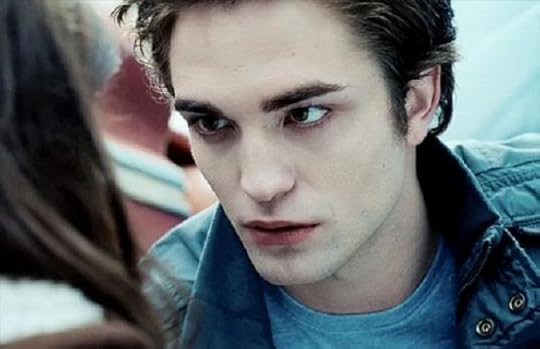
Didn’t want to cut into valuable staring time.
I’ve spilled a lot of words reviewing these terrible movies, and now I’m done. Long was the road, and hard, that leads from darkness into light. I’m finished. I can move on. Well, until I decide to review The Host.
Filed under: Projected Pixels and Emulsion, Yakmala! Tagged: boring as hell, Breaking Dawn 2, CGI abomination, Stephenie Meyer, twilight, uncanny valley, Yakmala!

March 12, 2014
The Future Will Be Carpeted
http://fanboycomics.net/index.php/fbc...
March 7, 2014
Lifetime Theater: Lizzie Borden Took an Ax
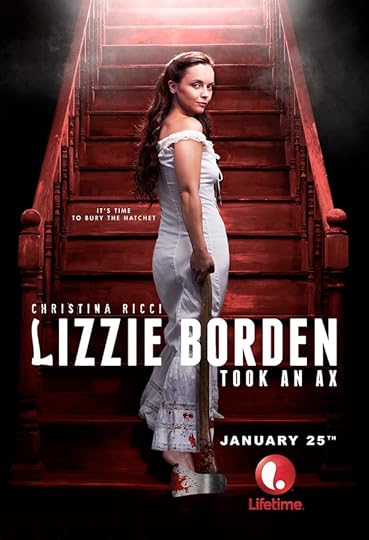
Class, thy name is Lifetime.
Ask someone about Lizzie Borden, and chances are you’ll get a schoolyard rhyme. You know the one: it begins with the title of this very episode of Lifetime Theater. There are regional variants (mine finished with the verse, “when she saw what she had done/she picked up the phone and dialed 911”), but it is overall remarkably constant. Both of my readers probably have it rattling around in their heads at this very moment. Ask someone about Lizzie Borden, and you’ll get that chant, but chances are you’ll get very little else. Lizzie has transcended her actual life to become a creature out of folklore: the deranged, axe-wielding madwoman who butchered both her parents. This week’s episode of Lifetime Theater, Lizzie Borden Took an Ax, agrees.
I got to know Lizzie in the same way as most others: I heard the rhyme at school and dutifully repeated it because it was the ‘80s and there was fuck all else to do. Eventually I learned that Lizzie was a real person, but it was not until I read a full account of the Borden case that I got arguably the most important aspect of the story: that she was acquitted. That’s right. Lizzie Borden was found not guilty of both murders. And yet, she persists as little more than shorthand for a parricidal butcher. I’m not suggesting that the courts are infallible, but it does seem to be a striking case of the reality of what transpired butting up against the folklore. The bulk of what I know from the case comes from Rick Geary’s The Borden Tragedy, part of his larger series on true crime. I can’t recommend these books highly enough. The highlight of Comic-Con every year is getting the newest book from the man himself and immediately devouring it on the sunny deck behind the convention center. All of these works are primary sourced, and The Borden Tragedy comes exclusively from the diaries of a local woman familiar with the Borden family. Whenever I interject about facts from the case, this is my source.
The year is 1892. Creepy local businessman Andrew Borden (Stephen McHattie) has two daughters: young and wild Lizzie (Christina Ricci) and elder and quiet Emma (Clea DuVall). They all live in a large home in Fall River, Massachusetts with Abby (Andrew’s second wife) and their maid Bridget Sullivan. One afternoon, Lizzie wanders into the living room to find that someone has thoughtlessly carved a hole in her father’s face. Much later, after the police have arrived and questioned everyone, they check upstairs to find that Abby has been murdered as well, which conflicts with Lizzie’s statement that Abby had gone off to visit a sick friend. The investigation immediately focuses on Lizzie, who had the means, motive, and opportunity to do it. The motive they ascribe in both the film and in history is money. Andrew had made a habit of helping Abby’s family financially and the two Borden sisters (spinsters both with little opportunity for respectable marriage) were watching their inheritance disappear. Though Bridget was at home, Lizzie had ample time to go in, beat both to death, and then “discover” the bodies.
Both the movie and the real case focuses on what, to my mind, is the most damning bit of evidence. Abby’s death was pinpointed to having occurred around 9:30, while Andrew’s happened around 11. This means that the killer murdered Abby, then lurked around the house for an hour and a half (never touching Lizzie or Bridget, both of whom were home at the time), before hopping out of hiding ninety minutes later to kill Andrew. Or (and this seems even odder), the murderer killed Abby, then left and came back to kill Andrew. Granted, this evidence is entirely circumstantial and based around the medical examiner’s findings (which could be flat out wrong), but when combined with Lizzie’s story of Abby receiving a note and going to visit a sick friend — when no note was ever found and Abby was in the house — it becomes a little more compelling.
The movie never gives us any other suspects. One character, dubbed by Mrs. Supermarket as Scruffy McHandsome, is shown lurking around the farm (and at one point making out with Lizzie), but he’s never named, never explained, and never given a single line of dialogue. There is a brief interlude in which a second axe-murder is mentioned, occurring while Lizzie is incarcerated, and then the film drops it completely. In real life, the murder was committed by a man who wasn’t in the country when the Bordens were killed. An early scene shows Andrew arguing over a debt, though nothing comes of this in the narrative. The movie even omits the stranger seen multiple times loitering outside the Borden home on the morning of the murders. Motive is similarly fuzzy: an earlier scene hints at the possibility of incest, though never strongly enough to make a dent. Lizzie herself is displayed as a rebellious party girl with a shoplifting habit (there is real world support for at least the second trait), though at least in the early going there’s some appeal to be found in her Disney Princess longing for “something more.” (You could almost chalk up this week’s Very Special Lesson to, “Want to grow as a woman? Murder your parents!”) The movie treats Lizzie’s burning of a dress as blatant destruction of evidence, when in reality there was a bit more nuance than that.
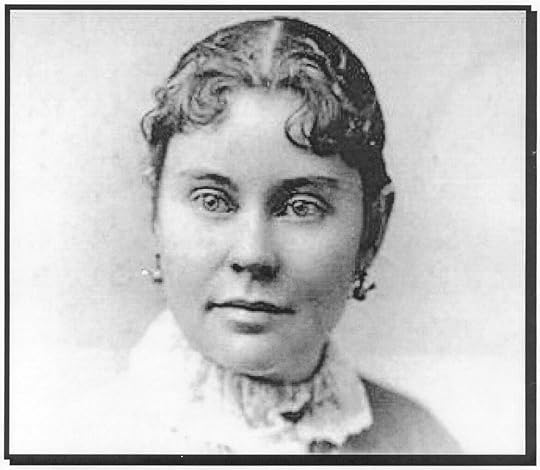
Behold, the pudgy face of evil.
The film strips away the ambiguity of the actual case to frame it more as a straightforward situation of justice being undermined. I’m fine with this — historical accuracy is not what I look for in a Lifetime movie. The essential problem with this approach is that it should have been a TV version of something like Jagged Edge or Presumed Innocent in which evidence keeps piling up on both sides of the case until the end features a stunning reveal of the true culprit. There is even the perfect chance for this with the bloody nightgown Lizzie wore during Abby’s murder, which she kept and stashed in a woodpile. (At the time, the hypothesis was that she had committed the murders the nude, thus explaining the lack of blood on her clothes. I’m certain this stemmed from responsible journalism and not the salacious image of a naked woman carrying an axe.) Instead, Lizzie comes clean to Emma in the closing moments. It’s treated as a shocking twist, yet for the entire movie, we’ve seen shots of a naked or nearly naked Lizzie clubbing both people to death. We knew it was happening, so it barely registers.
Whatever flaws there are in the movie do not extend to the cast. Ricci and DuVall are always great, and McHattie has carved out a welcome niche as a skull-faced baddie. Gregg Henry, Shawn Doyle, and Billy Campbell also appear in supporting roles. With a cast like this, I can’t help but wonder if the movie was intended for major release, or at least a more respectable channel. It’s possible the editing, which is the worst part, is due to this last minute change. The gore FX lend credence to this film having another intended home as they are entirely too good for Lifetime. While the unrepentant horror fan in me loves that they took the time to carve a convincing wound on Andrew, I can’t imagine the same was true for Lifetime’s intended audience. Finally, the music, all modern white guy blues and roll, was a baffling choice. Played at top volume, it was a contemporary sheen the proceedings did not need.
Like the case itself, the Lizzie of the movie is a question mark. We’re told a motive — money — but never see any evidence that this is fact. Another motive, Lizzie’s murky sexuality, is teased at, as we see her flirt with her father, Scruffy McHandsome, and a female party guest introduced in the third act who qualifies as this movie’s Stephen. Lizzie’s character might be in question, but her guilt never is. From the minute the movie begins to the smug confession she whispers in Emma’s ear at the end, the Lizzie of the film is an unrepentant monster. She’s not the Lizzie of history; she’s the Lizzie of that schoolyard rhyme.
Filed under: Projected Pixels and Emulsion Tagged: ax-based solutions to familial disharmony, Christina Ricci, forty whacks, Lifetime Theater, Lizzie Borden, Lizzie Borden Took an Ax

February 28, 2014
Now Fear This: Stake Land
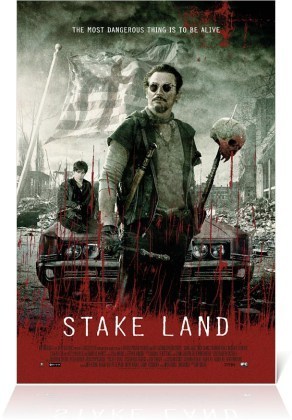
Lord help the mister…
About a year ago, I made a joke on Twitter that all one has to do to create a genre is to append “punk” as a suffix to any word (and thus I ushered “dentalpunk” into the world). My annoyance with this particular phenomena stems from the fact that the -punk part has come to be a completely meaningless appellation (much like -core before it), only serving to point out that one is talking about a genre rather than, say, a combination shotgun/drink mixer. When punk was first applied as a suffix with “Cyberpunk,” it was a quintessential descriptor if the genre. The cyber part applied to the advanced computer-centric technology, while the punk part was the irreverent ethos and the background of societal breakdown into postmodern tribes. Clint once argued that “steampunk” was losing meaning due to scope creep; I would argue that the punk part of that word was already meaningless in the vast majority of media bearing that title. When was the last time a steampunk cosplayer looked like anything other than an upper-class time-traveling Victorian? The only thing Victoriana and punk have in common is that they’re both from England.
While steampunk is long on the steam and short on the punk, the same can’t be said of all of these newly created subgenres. One in particular, splatterpunk, is little more than the punk part of the word, liberally covered with enough blood, gore, and entrails to open a sausage factory. Coined in the ‘80s to describe the excessively bloody horror that was coming into the vogue at the time, “splatterpunk” as a term was the “torture porn” of its day: a way for establishment types to dismiss a new direction they didn’t understand or appreciate, essentially lumping everything under a generic heading that’s code for “horror I don’t like.” To be fair, a lot of splatterpunk is terrible. But when you have true horror greats like Clive Barker, Jack Ketchum, and Joe Lansdale tipping their toes into the crimson pond of the genre, it’s probably not the best idea to dismiss it out of hand. Today’s movie, the 2010 survival horror Stake Land, is one of the better splatterpunk movies out there.
Stake Land takes place in a post-apocalyptic United States after a plague that has turned a large majority of the populace into vampires. Martin (TV’s Connor Paolo) is a normal kid whose family gets wiped out in one horrible night, and is himself only saved by the intervention of Man-With-No-Name hero Mister (Nick Damici who also co-wrote). Mister and Martin eke out an existence as Mad Max versions of the Winchester brothers, complete with aging muscle car. They’re headed resolutely north to the possibly fabled safe zone of New Eden, up in Canada, where it’s too cold for the bloodsuckers to function. Along the way they accumulate other survivors including battered nun Sister (Kelly McGillis, yes, that Kelly McGillis), pregnant waif Belle (pint-sized scream queen Danielle Harris), and ex-Marine Willie (Sean Nelson), marking Mister as belonging to the Josey Wales school of laconic badasses.
Stake Land is ostensibly a vampire movie, though the nature of the vampires themselves as well as the post-apocalyptic trappings mark it as a closer relative to the zombie picture. The vampires are more or less mindless eating machines, though the existence of one subspecies, (the berserkers, who have been around long enough for their ribcages to fuse over their hearts) hints at the possibility of other mutant breeds. True to its zombie heritage, the vampires are dangerous, though they are not the primary antagonists. Fellow humans, in the form of a cult called the Brotherhood, are the real bad guys. These religious nutballs have decided the plague of vampires has been sent by god, and do everything they can to help out, including dropping vampires into safe zones from a helicopter. Their leader, Jebediah Loven, develops an abiding hatred for Mister born of the fact of the latter’s inability to give a fuck about much beyond survival.
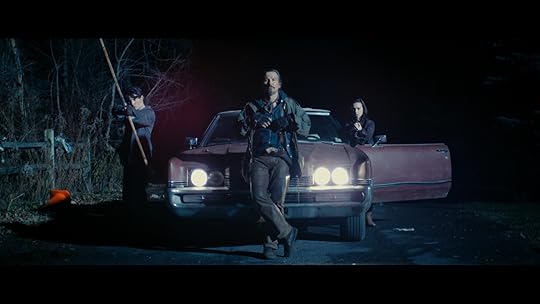
And the occasional badass group shot.
Stake Land is admirably cruel to its heroes, picking off even those that should have been immune through unwritten rules of genre. The film announces this with the first glimpse it gives us of a vampire: feeding on Martin’s baby sibling before carelessly dropping the tiny carcass in favor of bigger game. With a story like this, it would be easy to fall in love with the heroes and elevate them to cartoonish levels of badassery and drain any of the danger away. Mister — looking like a combination of Tom Savini’s Sex Machine and Andrew Robinson’s Scorpio killer — is very good at what he does, though the film gives the sense that a single slip up could mean his death as well. Fitting, since he is the symbolic father of his group of survivors, and the very first scene of the movie is of a father being fed upon and then mercy killed (by Mister, no less). He then raises the boy to survive, only relinquishing control when the kid moves in with a lady, just like a real dad.
Mister, by necessity, is a pragmatic man, which contrasts nicely with Sister’s (and Loven’s) more religious outlook. At several points in the film Mister responds to a religious platitude with concrete advice, most notably when he goes out into the rain to kill an infected nun. “Go with God,” Sister advises. “Lock the door,” Mister responds. The film lines up squarely on the side of pragmatism (and I would be lying if I said this did not endear me to it), with religion either being rendered useless (Sister) or evil (Loven). Mister never wastes his time cursing the Almighty, either. For him, that’s just as pointless as praying.
Belle occupies a place of outsized symbolic importance as well. Her pregnancy (as both my readers remember) marks her as an avatar of hope (and considering what happens to hope and who does it, further underlines the previous point). Belle also has shades of innocence and purity. Her pregnancy would prevent a complete alliance to those concepts, yet it’s there all the same. In one pivotal scene, she wears a white dress, yet it’s under a black leather jacket, hinting that her innocence is inside, protected by a tough shell of armor. She’s in stark contrast to a little girl who does in fact wear all white (and is shortly killed by the Brotherhood).
Stake Land is far from a perfect film — the pervasive voiceover in particular should be excised — though it’s nifty splatterpunk, much more intelligent than its title suggests, and filled with gorgeously stark exteriors. Larry Fessenden, the patron saint of flawed-but-fascinating low-budget horror pops up in a welcome cameo as a friendly bartender and serves as one of the film’s producers, putting his stamp of approval on the proceedings. Trust in the Fessenden, and then watch his 1995 flick Habit as the weirdest vampire double bill around.
Filed under: Projected Pixels and Emulsion Tagged: Now Fear This, post apocalypse, Stake Land, survival horror, vampires, zombies




